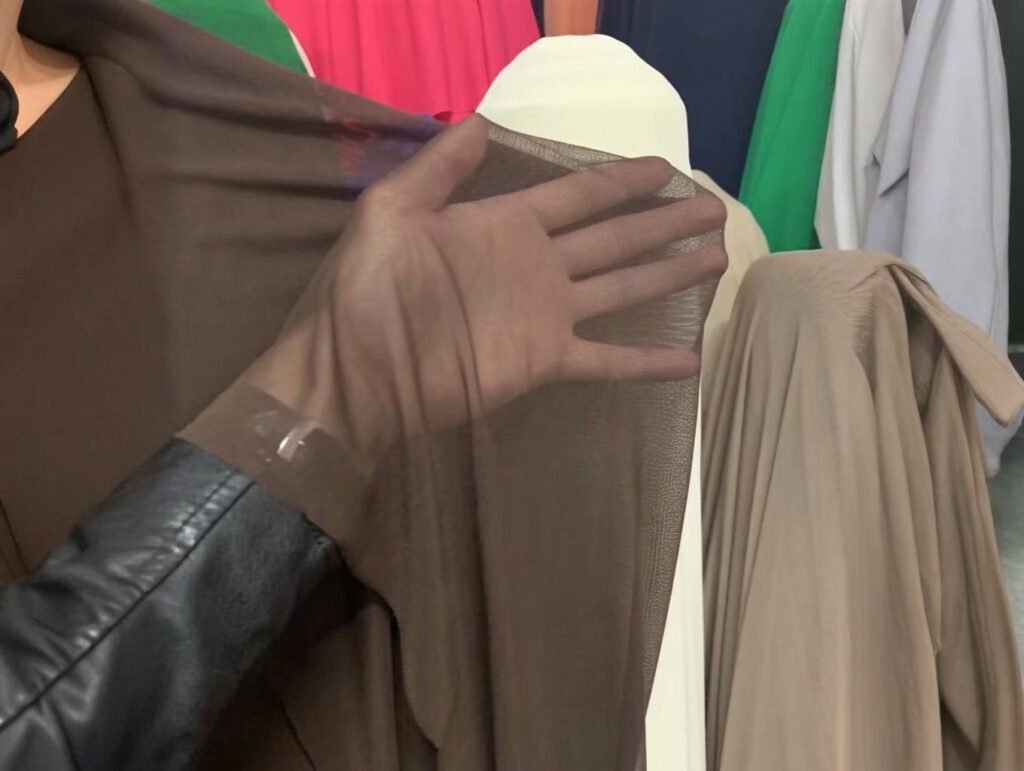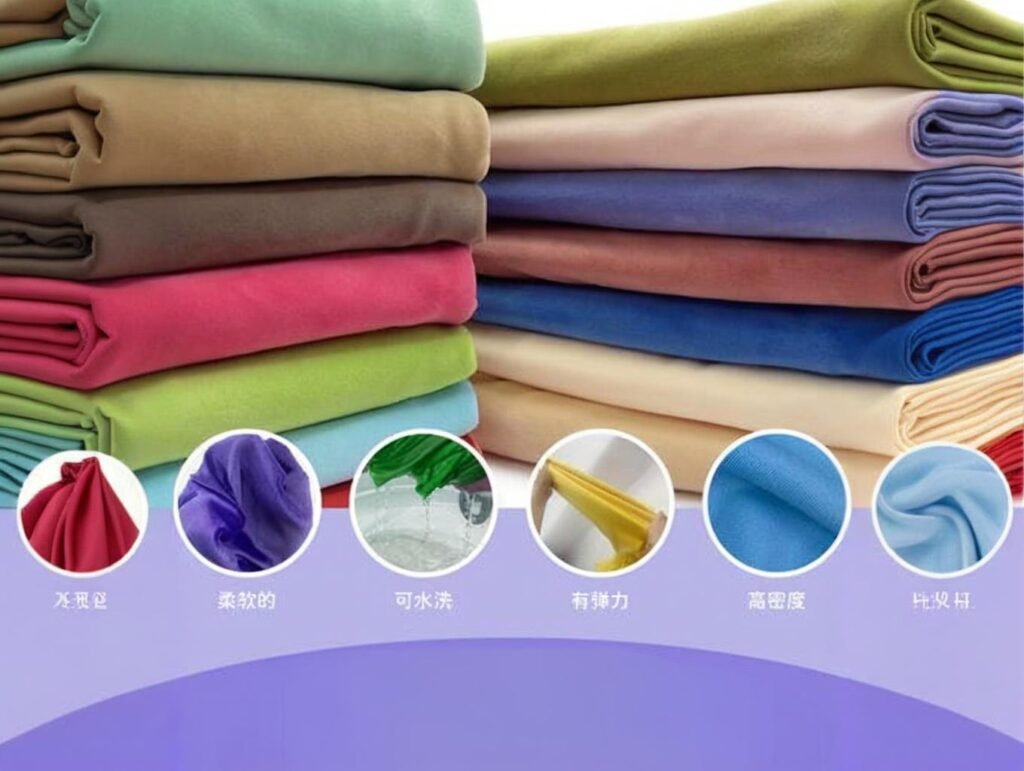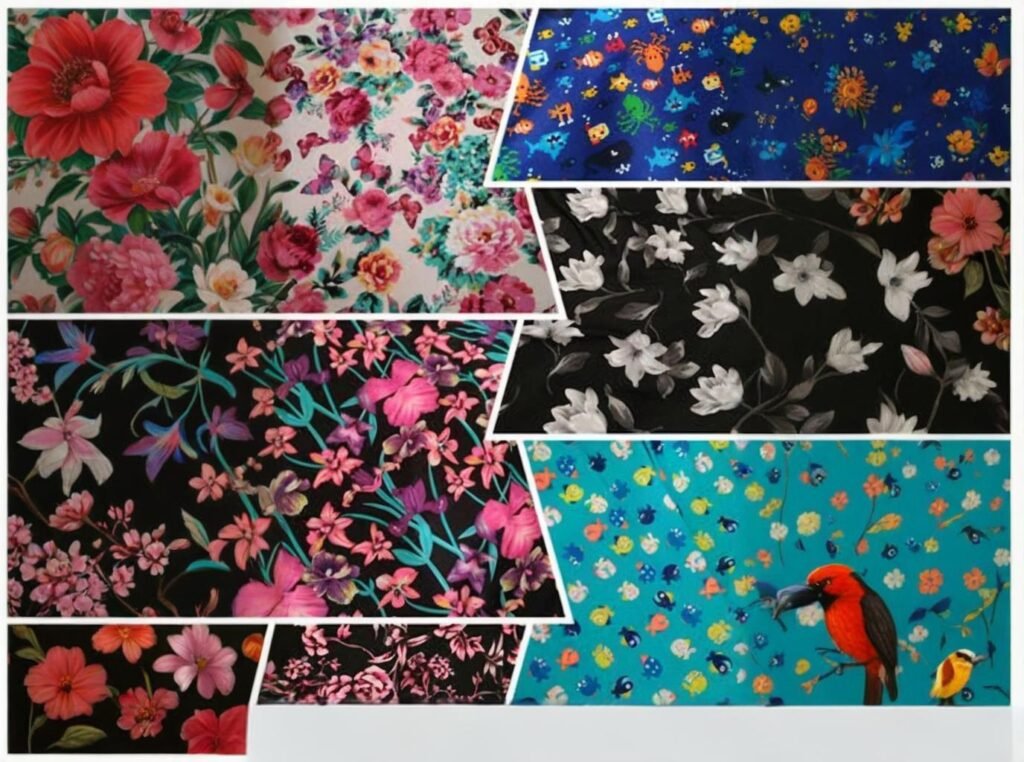
From yoga leggings to compression garments, Spandex has revolutionized the textile industry with its extraordinary stretch and recovery capabilities. But while most consumers know it as the secret to their second-skin activewear, for manufacturers, Spandex presents a far more complex story—one that spans chemical engineering, performance testing, and precise manufacturing practices.
Spandex is a synthetic elastic fiber made from polyurethane, known for its exceptional stretch and recovery. It is commonly used in sportswear, underwear, and blended textiles.
With rising demand for comfort, performance, and body-contouring apparel, Spandex has become a foundational ingredient in modern textiles. This guide walks textile professionals through its origin, composition, blend ratios, performance metrics, processing challenges, sustainability issues, and sourcing tips. Whether you’re developing a new product line or optimizing an existing one, understanding Spandex at a technical level is essential to making smart manufacturing decisions.
Now let’s rewind to 1958. A chemist at DuPont named Joseph Shivers developed the world’s first polyurethane-based stretch fiber. The fashion world would never be the same. But what makes Spandex so resilient—and how do you actually work with it?
What Is Spandex and How Is It Made?
Spandex is a synthetic fiber made primarily from a long-chain polyurethane polymer. It’s known for its ability to stretch up to 500–700% of its original length and snap back into shape without deformation. The fiber is created through a process called solution dry spinning, which allows for continuous filament production and high elasticity retention.
Spandex is made from segmented polyurethane through solution dry spinning, allowing it to stretch 5–7 times its length and return to its original shape without breaking.
Spandex Fiber Chemistry and Production
a. Fiber Structure and Elastic Properties
Spandex is a block copolymer, consisting of:
- Soft segments (polyether or polyester): Provide stretch
- Hard segments (urethane links): Provide resilience and recovery
| Property | Value/Range |
|---|---|
| Elongation at break | 500–700% |
| Recovery rate (1-hour test) | ≥95% |
| Density | \~1.2 g/cm³ |
| Melting point | 230–260°C |
b. Manufacturing Process: Solution Dry Spinning
- Polymerization: Create the polyurethane prepolymer
- Solvent Mixing: Dissolve the prepolymer in a solvent like DMAc
- Extrusion: Spin the solution through a spinneret
- Evaporation: Use hot gas to remove the solvent
- Drawing: Stretch and heat-set the fibers
- Winding: Wind onto spools for weaving or knitting
This process gives Spandex its ultra-fine filament size, which is why it blends so well with other yarns.
c. History and Branding
- 1958: Invented by Joseph Shivers at DuPont
- 1962: Launched under the brand name Lycra®
- Today: “Spandex” (US), “Elastane” (EU), “Lycra” (branded)
“Lycra” is a trademarked name owned by The LYCRA Company and refers to a specific type of Spandex that meets higher quality control standards.
How Does Spandex Compare to Other Elastic Fibers Like Lycra or Elastane?
Spandex, Lycra, and Elastane are essentially the same fiber but differ in branding and quality assurance. Spandex is the generic term (mainly used in the U.S.), Elastane is used in Europe and Asia, and Lycra is a branded version of high-quality Spandex fiber from The LYCRA Company.
Spandex, Lycra, and Elastane refer to the same polyurethane-based fiber. Lycra is a premium, branded version with stricter performance standards.
Fiber Identity and Market Positioning
a. Terminology Comparison
| Name | Region/Use | Owned By |
|---|---|---|
| Spandex | USA (generic term) | No specific owner |
| Elastane | EU/Asia (technical term) | No specific owner |
| Lycra® | Global (premium brand) | The LYCRA Company (formerly DuPont) |
b. Technical Differences
| Property | Generic Spandex | Lycra® Branded Spandex |
|---|---|---|
| Elasticity | 400–600% | 500–700% |
| Dye Resistance | Moderate | Enhanced |
| Recovery After Heat | 85–90% | 95%+ |
| Quality Certification | Varies | Consistent + tested |
c. Manufacturer Considerations
- Brands like Nike and Under Armour often specify Lycra in their tech packs due to its proven recovery and durability.
- Generic Spandex may be used in lower-cost applications like linings, low-stretch fashionwear, or disposable garments.
A high-end European yoga brand reported 3x fewer returns when switching from generic elastane to Lycra® yarns in their leggings—due to better shape retention over time.
Which Types of Fabrics Commonly Blend with Spandex?

Spandex is rarely used on its own. It’s almost always blended with other fibers to enhance elasticity, fit, and performance. The most common blends include cotton-Spandex, polyester-Spandex, and nylon-Spandex, each offering different advantages for comfort, durability, and moisture control.
Spandex is commonly blended with cotton, polyester, and nylon to improve stretch and recovery. These blends are widely used in activewear, underwear, and stretch denim.
Popular Spandex Fabric Blends
a. Cotton + Spandex
| Blend Ratio | Typical Use | Benefits |
|---|---|---|
| 95% Cotton / 5% Spandex | T-shirts, leggings, underwear | Natural comfort + stretch for daily wear |
- Feels soft and breathable, ideal for base layers and yoga wear
- Needs better shrinkage control during processing
b. Polyester + Spandex
| Blend Ratio | Typical Use | Benefits |
|---|---|---|
| 85–90% Polyester / 10–15% Spandex | Sportswear, compression garments | Durability, moisture-wicking, performance fit |
- Often used in performance gear due to quick-drying capabilities
- Dyeing polyester blends requires careful heat control to avoid damaging Spandex
c. Nylon + Spandex
| Blend Ratio | Typical Use | Benefits |
|---|---|---|
| 80–85% Nylon / 15–20% Spandex | Swimwear, shapewear | Excellent recovery, smooth surface, high stretch |
- Very common in body-hugging garments
- Offers high durability and sleek aesthetic finish
d. Other Niche Blends
- Modal-Spandex: Ultra-soft, used in loungewear
- Rayon-Spandex: Cost-effective stretch for fashion wear
- Wool-Spandex: Rare, high-end thermal gear (e.g., base layers for cold climates)
e. Performance Matrix by Blend Type
| Property | Cotton-Spandex | Polyester-Spandex | Nylon-Spandex |
|---|---|---|---|
| Comfort | ★★★★★ | ★★★ | ★★★★ |
| Durability | ★★★ | ★★★★★ | ★★★★★ |
| Moisture Wicking | ★★ | ★★★★★ | ★★★★ |
| Stretch Recovery | ★★★★ | ★★★★ | ★★★★★ |
| Color Retention | ★★★ | ★★★★★ | ★★★★ |
At SzoneierFabrics, clients often order custom-blended fabrics (e.g., poly-nylon-Spandex hybrids) to combine the breathability of nylon with the structure of polyester and the stretch of Spandex.
What Are the Key Properties That Make Spandex Ideal for Stretch Textiles?
Spandex is unique because it doesn’t just stretch—it recovers. That means garments made with Spandex won’t sag, wrinkle, or deform after being worn, stretched, or washed. This property, combined with its softness and low weight, makes Spandex a top-tier performance fiber.
Spandex is ideal for stretch textiles due to its high elongation (up to 700%), excellent recovery, lightweight nature, and resistance to wrinkling and sagging over time.
Core Functional Benefits of Spandex
a. High Stretchability
- Spandex can stretch up to 5–7 times its original length
- Perfect for applications requiring freedom of motion
b. Recovery & Shape Retention
- Unlike rubber, Spandex recovers fully, maintaining the garment’s shape over repeated uses
- Important for tight-fit garments like bras, shapewear, and athletic gear
c. Lightweight and Low Bulk
- Extremely fine fibers allow Spandex to blend invisibly into fabric structures
- Adds functionality without adding weight
d. Wrinkle and Abrasion Resistance
- Maintains a smooth surface, making it suitable for outerwear and fashion sportswear
- Withstands multiple wash cycles with minimal fiber damage
e. Moisture Resistance
- Doesn’t absorb water but dries quickly when blended with other hydrophobic fibers
- Ideal for sweat-intensive uses like gymwear or performance base layers
How Is Spandex Used Across Different Textile Applications?

Spandex is a versatile performance fiber that has become essential in both fashion and technical textiles. Its ability to stretch and recover makes it ideal for garments that require close fit, movement, and shape retention. From athleisure to medical textiles, Spandex is everywhere.
Spandex is used in activewear, underwear, swimwear, shapewear, medical compression garments, and stretch denim due to its excellent elasticity and comfort.
Spandex Applications by Industry
a. Sportswear & Activewear
- Found in leggings, compression tops, shorts, and cycling wear
- Enhances freedom of movement, improves muscle support, and resists deformation
- Common blends: Polyester-Spandex, Nylon-Spandex
Example: Nike’s Dri-FIT series and Lululemon’s Align leggings use high-Spandex content fabrics for maximum comfort and contouring.
b. Intimate Apparel & Underwear
- Adds stretch to bras, panties, and seamless undergarments
- Helps retain shape after repeated wear
- Common blend: Cotton-Spandex, Modal-Spandex
c. Swimwear & Surfwear
- Requires both chlorine resistance and high elasticity
- Uses Nylon-Spandex blends with UV protection and anti-sag features
d. Medical Textiles
- Used in compression socks, bandages, and support garments
- Promotes circulation and muscle recovery
- Requires precise recovery control and skin-safe certification (OEKO-TEX)
e. Denim & Stretch Woven Fabrics
- Spandex is blended with cotton and polyester for stretch denim
- Allows skinny jeans to maintain comfort without bagging
| Application | Typical Blend | Spandex % | Function |
|---|---|---|---|
| Sportswear | Polyester/Nylon + Spandex | 10–20% | Stretch, breathability, fast recovery |
| Underwear/Intimates | Cotton/Modal + Spandex | 5–10% | Softness, fit, daily comfort |
| Swimwear | Nylon + Spandex | 15–25% | Flexibility, water resistance |
| Shapewear | Nylon/Poly + High Spandex | 20–40% | High compression, stretch control |
| Compression wear | Nylon + Spandex | 20–30% | Medical-grade support |
What Are the Challenges in Dyeing and Finishing Spandex Blended Fabrics?
Dyeing Spandex is challenging because its polyurethane base is heat-sensitive and vulnerable to degradation from chemicals, high temperatures, and tension. The finishing process must be gentle and pH-controlled, or the fabric can lose elasticity, shrink, or discolor.
Dyeing Spandex blends is difficult due to the fiber’s heat sensitivity. Careful temperature control, pH balance, and low-stress processing are required to avoid elasticity loss.
Technical Issues in Processing Spandex
a. Dyeing Temperature Sensitivity
- Spandex begins to degrade above 70°C
- Jet dyeing and soft-flow dyeing are preferred techniques to protect the fiber
- Carrier agents are used for polyester-Spandex blends to dye at lower temps
| Dye Type | Compatible Blend | Max Temperature | Notes |
|---|---|---|---|
| Acid Dyes | Nylon-Spandex | 60–70°C | Requires pH 4.5–5.5 |
| Disperse Dyes | Polyester-Spandex | 80–110°C | Use with caution and low tension |
| Reactive Dyes | Cotton-Spandex | 60°C max | Spandex portion does not absorb dye |
b. Finishing Considerations
- Avoid silicone-based softeners unless tested, as they may damage the fiber
- Set at low heat (\~130°C) in tensionless dryers to avoid bagging
- Ensure pH is neutral or slightly acidic post-wash
c. Common Problems and Prevention
| Issue | Cause | Solution |
|---|---|---|
| Loss of Stretch | Overheating or alkaline pH | Use low-temp, pH-controlled dye cycles |
| Yellowing | Oxidation or poor heat setting | Pre-treat and avoid prolonged exposure to UV |
| Uneven Color | Fabric overstretched during dyeing | Use relaxed dyeing systems |
| Fiber Breakage | High mechanical stress | Use paddle/soft-flow machines |
d. What Happens When It Goes Wrong
A North American shapewear brand saw 18% of its returns tied to “loss of fit” after washing. The root cause was traced to excessive heat during piece dyeing, which weakened the Spandex yarns and led to irreversible bagging in critical stretch zones.
Is Spandex Sustainable? What Are the Eco-Friendly Alternatives?

While Spandex revolutionized stretch textiles, it has long faced criticism for being non-biodegradable, petroleum-based, and difficult to recycle. However, the industry is now embracing eco-friendly innovations—from recycled Spandex (r-Elastane) to bio-based elastomers—making it possible for textile manufacturers to align with sustainability goals.
Spandex is not naturally biodegradable or recyclable, but newer alternatives like recycled Spandex (GRS-certified) and bio-based elastane are improving its sustainability profile.
Spandex and Environmental Impact
a. Environmental Challenges
| Factor | Spandex Performance |
|---|---|
| Biodegradability | ❌ Not biodegradable |
| Recyclability | ⚠ Limited (difficult to separate) |
| Origin | Derived from fossil fuels |
| End-of-life impact | Long decomposition in landfills |
b. Emerging Green Solutions
- Recycled Spandex (r-Elastane)
- Derived from post-industrial or post-consumer elastic waste
- Must be GRS (Global Recycled Standard) certified
- Offers same stretch as virgin Spandex with reduced carbon footprint
- Bio-Based Elastane
- Partially derived from renewable feedstocks
- Still under early-stage adoption but promising for future biodegradability
- Dope-Dyeing Integration
- Reduces water, energy, and chemical waste during fiber coloration
- Can be paired with recycled Lycra for a full-sustainability story
- Blending with Sustainable Fibers
- Cotton-Spandex and bamboo-Spandex combinations reduce overall synthetic load
- Use of organic cotton, TENCEL™, or modal improves lifecycle analysis
c. What Major Brands Are Doing
- Adidas and H\&M have trialed recycled Spandex in performance and athleisure lines
- Patagonia has explored bio-based elastomers for hybrid outdoor gear
- Lululemon announced investments in closed-loop Lycra recovery initiatives
d. Key Certifications for Sustainable Spandex
| Certification | What It Verifies |
|---|---|
| GRS (Global Recycled Standard) | Use of verified recycled elastane |
| OEKO-TEX Standard 100 | Free from harmful chemicals |
| bluesign® | Responsible chemical management |
| ZDHC MRSL | Manufacturing Restricted Substances List compliance |
How Can Textile Manufacturers Source High-Quality Spandex for Production?
Sourcing Spandex responsibly means going beyond just price. Textile manufacturers should prioritize yarn performance, certification, supplier credibility, and MOQ flexibility. Working with partners like SzoneierFabrics ensures not only quality but also fast development, customization, and sustainability compliance.
To source quality Spandex, work with certified suppliers offering performance-tested, customizable blends, low MOQs, and OEKO-TEX or GRS certifications.
Sourcing Spandex Smartly
a. What to Look for in a Supplier
- Experience with Spandex blending & dyeing
- Certifications (OEKO-TEX, GRS, ISO 9001)
- Customization options (GSM, fiber blend ratios, dyeing method)
- MOQ flexibility for pilot orders and small-batch sampling
- Sampling speed and development support
b. Common Mistakes in Spandex Procurement
| Mistake | Impact |
|---|---|
| Choosing unverified suppliers | Poor recovery, yellowing, non-compliance issues |
| Focusing only on low price | May compromise stretch and durability |
| Ignoring testing certifications | Risk of chemical non-compliance |
c. Why Work with SzoneierFabrics?
- Over 18 years of experience in Spandex fabric development
- Custom blend creation (e.g., 220GSM cotton-Spandex for leggings)
- Low MOQs (starting from 50 meters for custom dye or spec)
- Fast 3–5 day sampling turnaround
- Free consultation for new fabric design or product line testing
- Certified by OEKO-TEX, ISO 9001, and capable of supplying GRS-approved yarn blends
“Szoneier helped us develop a 4-way stretch bamboo-Spandex blend for our new yoga capsule. The first batch sold out in 10 days. Their turnaround time and technical insight made a huge difference.” — Buying Director, Australian eco-brand
Want to Customize Spandex Fabric with Certified Performance?
Whether you’re launching activewear, shapewear, or sustainable fashion, SzoneierFabrics can help you develop custom Spandex fabrics that match your performance, pricing, and brand values.
✅ OEM/ODM service for cotton-Spandex, nylon-Spandex, modal-Spandex, and more ✅ 100% quality assurance with free sampling ✅ Fast lead times (10–15 days for production) ✅ Low MOQ starting at 50 meters ✅ Certified with OEKO-TEX, ISO, GRS (upon request)
Contact SzoneierFabrics today for a free quote, custom development plan, or fabric swatch pack tailored to your market needs.

